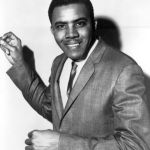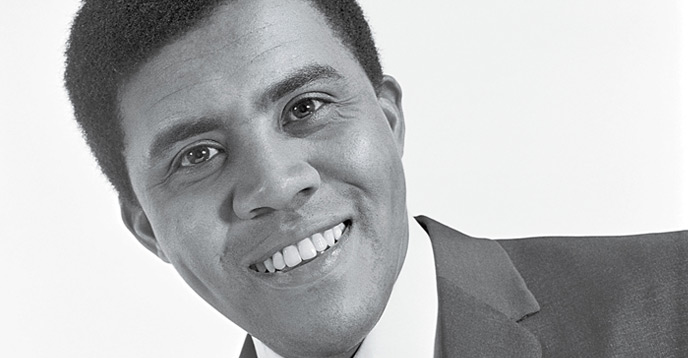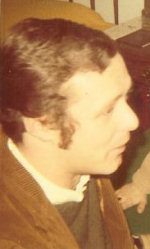SPOTLIGHT SOUND NO. 15 * Frank Sinatra * WXYZ (11/21/66)
![]()
By Randy Lewis | LA TIMES Staff Writer | November 19, 2014, 3:55 PM
Any suspicions that soul singer Jimmy Ruffin might have harbored hard feelings after his younger brother, David, snatched one of the great gigs in 1960s pop music out of his hands would have been dispelled when the siblings came together in 1970 to collaborate on a harmonious update of Ben E. King’s signature ode to solidarity, “Stand By Me.”
“Jimmy Ruffin was a phenomenal singer. He was truly underrated.”
– Berry Gordy, founder of Motown Records

Jimmy Ruffin, who died Monday in a Las Vegas hospital at age 78, had been in the running to join the lineup of Motown Records’ great male vocal group the Temptations in 1964. But when the other members of the group heard David sing, they gave him the job for his slightly grittier sound.
That didn’t sideline Jimmy for long: He heard a song that Motown writers William Weatherspoon, Paul Riser and James Dean had crafted with the Spinners in mind, and persuaded them to let him record it.
“What Becomes of the Brokenhearted,” a lament for the anguish a man feels in the face of love that has departed, gave Ruffin his first Top 10 hit on the Billboard Hot 100 singles chart. It ignited a solo career that comprised 10 other charted singles, the last of which, “Hold On To My Love,” brought him back to the Top 10 in 1980 during a new round of popularity, the result of his move to England to further his career overseas.
“Jimmy Ruffin was a phenomenal singer,” Motown founder Berry Gordy said in a statement Wednesday. “He was truly underrated because we were also fortunate to have his brother, David, as the lead singer of the Temptations, who got so much acclaim. Jimmy, as a solo artist, had ‘What Becomes of the Brokenhearted,’ one of the greatest songs put out by Motown and also one of my personal favorites.”
MCRFB note: For the rest of this Los Angeles Times Jimmy Ruffin Obituary article (November 19, 2014), please GO HERE.

![]()
https://www.youtube.com/watch?v=UQU4sIn96M4
![]()
![]()
![]()
 From the MCRFB news archive: 1970
From the MCRFB news archive: 1970
Station Air Talents Control Shows: Avails Audience Appeal via Telephone
DETROIT — Personal contact blended with a consistent music policy directed at adults is paying off for WHFI-FM, a stereo station. Tom Danley, in slightly over a year at the station, has taken it from billings of only $20,000 per year to approximately $250,000 this fiscal year and by next year expects to be far above those figures.

The first thing Danley did upon arriving at the station, which is located in the suburbs of Detroit in Birmingham, was raid-local AM stations for top-flight personalities. Then he gave them not only control of their show, but made them available to the listeners not only through radio, but through the telephone.
There are three direct phone lines into the studio “and the phones are constantly ringing . . . sometimes all three at once,” said Danley.
He confessed that once a phone call received by evening Don Alcorn was a wrong number. “Turned out she’d never heard of WHFI-FM or Alcorn and thought she was kidding her when he told her she was on the air. He convinced her into getting an FM radio and then helped her dial it to 94.7, chatting with her all the time. ‘Is that me,’ she yelled, after she got the station. I think she’s now a confirmed WHFI-FM fan.”
Danley said it would be difficult to find at least 60 seconds when those phones are not ringing . . . even on the all-night show. The air personalities — which includes music director Marc Avery, Lee Alan, Joey Ryan, program director Don Zee, Alcorn, and all-night man Bob Bereten — can talk when they want to . . . segue when they want to . . . “they’re in complete control of their show,” said Danley.
The air personalities operate from a playlist of about 100 records, plus a huge volume of albums from which oldies are taken. The oldies are records that were previous Top 40 hits which fit the uptempo easy-listening format of the station. The only restriction is that is that no more than three oldies can be played per show, although the air personality doesn’t have to play any if he doesn’t want to.
Chain Planned
WHFI-FM is on an upgrading drive and the company plans to grow into a chain of stations . . . all of them strictly FM. The station is building a new station and will move into completely new facilities in October.
“FM radio has arrived,” said Danley, “especially in regards to being a profit vehicle for advertisers. I have never received so many call-ins from potential clients . . . listeners who operates businesses and want us to come out and talk to them about an advertising schedule on the station. And I’ve worked for some major stations.”
To spur further call-ins, WHFI-FM has a series of brief promotions on the air asking: “Mr. Businessman, are you listening to WHFI right now? So are a lot of other people.” WHFI-FM is also very promotional-minded off the air. “I tell potential clients there’s no such thing as ‘one’ place to advertise. It’s a valid rule for us to follow, too. So, we’re involved in everything, including bumper stickers.”
The music policy that Danley installed when he first came to the station in August, 1969, was consistency.” Previously, the music format was in the right direction (Tom Jones and Pet Clark), he felt, but occasionally heavier records were thrown in. Danley set a more consistent policy on record. “The sound is hard to describe, but you can more or less tell when you turn on the station now.” END
(Information and news source: Billboard; October 3, 1970).
![]()